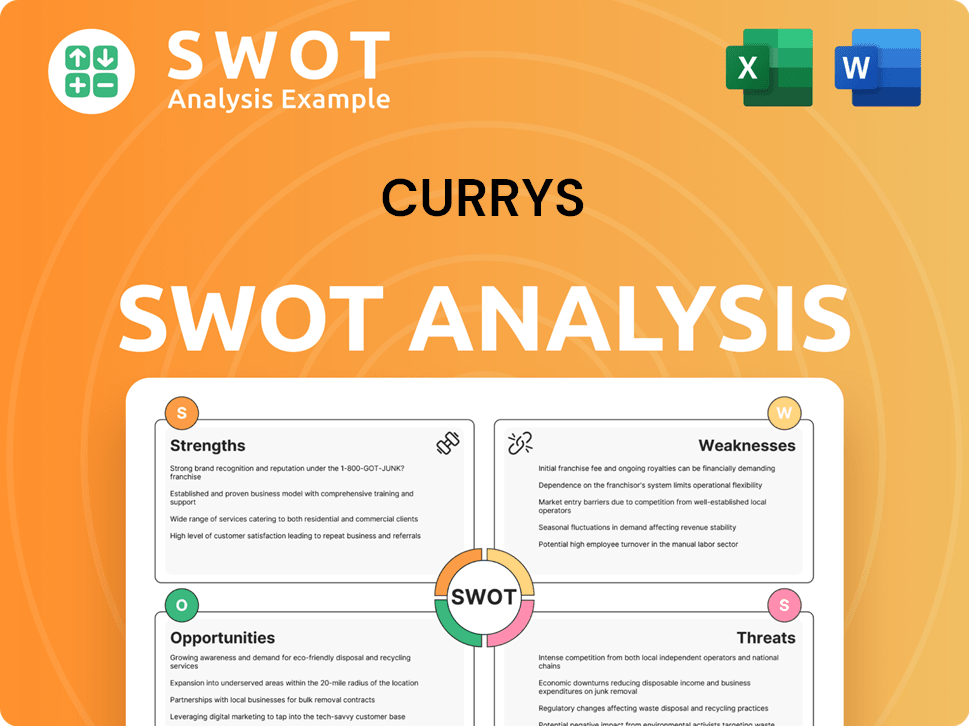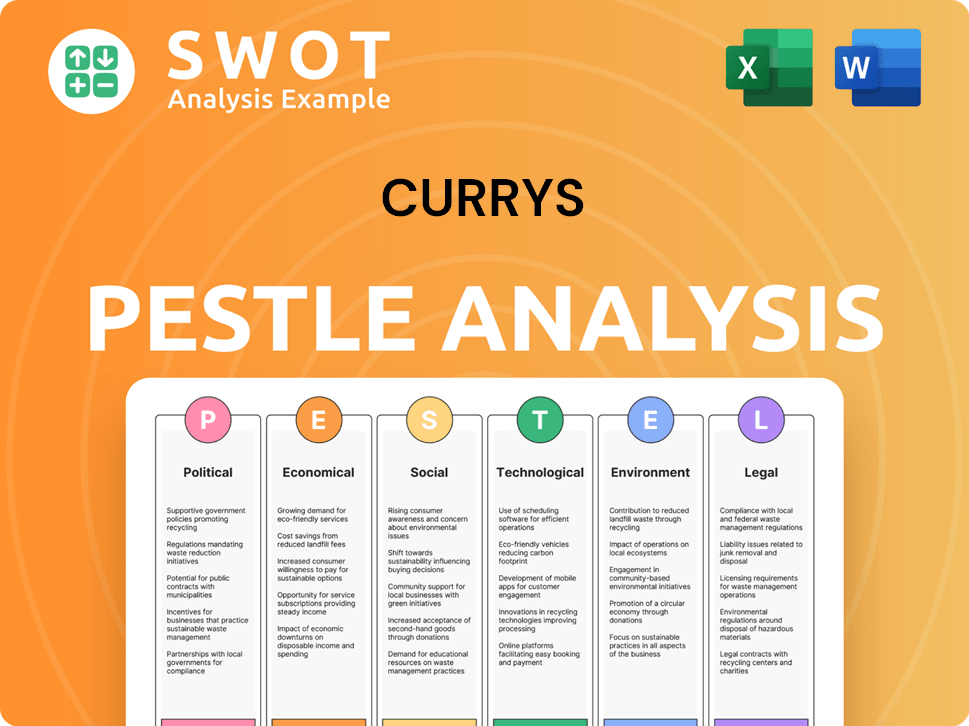Currys Bundle
How Does Currys Thrive in the Tech Retail World?
Currys, a leading Currys SWOT Analysis, dominates the technology retail landscape across the UK, Ireland, and the Nordics. With a vast network of stores and a strong online presence, understanding Currys' operations and revenue streams is key. The company's impressive financial performance, including a significant increase in adjusted Profit Before Tax, makes it a compelling subject for analysis.

This deep dive into Currys explores its omnichannel approach, examining how the electronics retailer generates revenue through product sales and lucrative after-sales services. We'll dissect the Currys business model, from its extensive store network to its digital strategies, and analyze its recent financial successes. Furthermore, we will touch on Currys' history and evolution, providing insights into its market position and future plans.
What Are the Key Operations Driving Currys’s Success?
Currys, a prominent electronics retailer, operates on an omnichannel retail model, providing a wide array of technology products and services across the UK, Ireland, and the Nordics. This approach allows customers to shop both online and in physical stores, offering flexibility and convenience. The company's core offerings include consumer electronics, computing, domestic appliances, and mobile devices, catering to diverse customer needs.
The company's value proposition centers on making technology accessible, affordable, and sustainable. Currys focuses on providing a full lifecycle of technology services, including repair, recycling, and reuse programs. This commitment to sustainability, combined with financial solutions like 'Currys Flexpay,' enhances its market differentiation and customer appeal.
Currys' business model is supported by meticulously managed operational processes. The company's operations are designed to efficiently deliver products and services to customers. Key elements include a large repair facility, strategic sourcing, and robust distribution networks.
Currys operates Europe's largest technology repair facility in Newark, UK, and a sourcing office in Hong Kong. Extensive distribution networks are centered in Newark and Jönköping, Sweden, ensuring efficient delivery. Strategic partnerships, such as with Maersk, enhance supply chain management and support decarbonization efforts, aiming to save over 800 tonnes of GHG emissions in the 2024-2025 financial year.
Currys offers credit solutions like 'Currys Flexpay' to improve affordability; its adoption increased by 250 basis points to 23% during peak trading. The company focuses on extending the life of technology through repair, recycling, and reuse. Partnerships with tech giants such as Microsoft, Apple, and Samsung provide authorized repair services, enhancing customer support.
The Currys supply chain is supported by strategic partnerships, including Maersk, which has evolved from an ocean carrier to a supply chain management partner. This partnership facilitates the global movement of thousands of products. Currys is also focused on decarbonization efforts, using Maersk ECO Delivery for imports.
Currys differentiates itself through comprehensive support and service offerings. These include extended warranties, repair services, and recycling programs. This approach makes technology more accessible, affordable, and sustainable, enhancing its competitive advantage in the UK retail market. For more information, see Competitors Landscape of Currys.
Currys' operations are characterized by a strong focus on customer service, sustainability, and efficient supply chain management. The company’s commitment to providing a full lifecycle of technology services, including repair and recycling, sets it apart. Strategic partnerships and investments in infrastructure support its omnichannel retail model.
- Europe's largest technology repair facility in Newark, UK.
- Strategic sourcing office in Hong Kong.
- Distribution networks centered in Newark and Jönköping, Sweden.
- Partnerships with Maersk for supply chain and decarbonization.
- Focus on 'Currys Flexpay' and authorized repair services.
Currys SWOT Analysis
- Complete SWOT Breakdown
- Fully Customizable
- Editable in Excel & Word
- Professional Formatting
- Investor-Ready Format

How Does Currys Make Money?
Understanding how Currys, a leading electronics retailer, generates revenue is key to grasping its business model. Currys business model hinges on a multi-faceted approach, combining product sales with a growing emphasis on high-margin services. This strategy aims to diversify revenue streams and build customer loyalty.
Currys operations are structured to maximize profitability through both product sales and service offerings. The company has been strategically shifting towards more predictable and profitable revenue streams, focusing on 'solution sales' and services to enhance its financial performance.
The Brief History of Currys reveals the evolution of its revenue strategies. These strategies have adapted to changing consumer behaviors and market dynamics, ensuring sustained growth and relevance in the competitive UK retail landscape.
Currys' revenue streams are primarily divided into product sales and services, with services playing an increasingly important role. This shift is designed to boost margins and provide more recurring revenue. The company’s approach to monetization is innovative, focusing on customer solutions and enhanced service offerings.
- Product Sales: This is the primary revenue source, encompassing consumer electronics, home appliances, computing, and mobile devices sold through online and physical channels.
- Services: This is a growing revenue stream that contributes to higher gross margins. Services include:
- Credit and Protection Plans: Offerings like Currys Flexpay enable customers to afford technology, with credit adoption reaching 23% during peak trading periods.
- Repairs, Maintenance, and Technical Support: Currys operates Europe's largest technology repair facility and offers services like RepairLive, which allows for tech repairs via video calls.
- Installation and Delivery: Services such as two-man deliveries and qualified installations for complex items like gas appliances contribute to overall revenue.
- Connectivity: The mobile virtual network operator (MVNO) iD Mobile in the UK has shown strong growth, reaching over 1.9 million subscribers, a 34% year-over-year increase.
Currys PESTLE Analysis
- Covers All 6 PESTLE Categories
- No Research Needed – Save Hours of Work
- Built by Experts, Trusted by Consultants
- Instant Download, Ready to Use
- 100% Editable, Fully Customizable

Which Strategic Decisions Have Shaped Currys’s Business Model?
Currys, a prominent electronics retailer, has undergone significant transformations to adapt to the evolving demands of the market. A key milestone was the rebranding from Dixons Carphone plc to Currys plc in September 2021, signaling a shift towards a more customer-centric approach. This move aimed to integrate physical and digital channels, enhancing the overall shopping experience for consumers.
The company's strategic focus on its omnichannel model has been crucial. Investments in both online and in-store experiences have proven beneficial, as customers increasingly prefer the flexibility of shopping across different channels. This approach allows Currys to meet diverse customer preferences and maintain a strong market presence.
Currys continues to adapt and evolve in the competitive UK retail landscape. Its ability to navigate challenges and leverage opportunities is central to its business model and operational success. The company's strategic initiatives and focus on customer experience are key to its ongoing performance.
Currys has implemented several strategic moves to strengthen its market position. Expansion into services and the circular economy, including repairs, recycling, and reuse, provides a competitive edge. Strategic partnerships with tech giants like Microsoft, Apple, and Samsung for authorized repair services also differentiate Currys.
Currys benefits from several competitive advantages. Its scale and omnichannel presence, with 708 stores and a robust online platform across six countries, provide a significant market-leading position. The services-led model, focusing on high-margin services, generates recurring revenue. Data utilization from loyalty programs enhances customer experiences.
The rebranding from Dixons Carphone plc to Currys plc in 2021 was a pivotal moment. This reflected a commitment to modern consumer demands and integrated physical and digital channels. The company has focused on strengthening its omnichannel model. The company is well-positioned to benefit from emerging trends like AI-powered technology, holding a 75% market share in AI laptops.
The retail sector faces intense competition from both specialist and non-specialist retailers. Economic pressures, such as inflation and rising interest rates, have affected consumer confidence. Despite these challenges, Currys has demonstrated strong cost discipline. The adjusted PBT for the year ending May 3, 2025, is expected to be around £162 million, a 37% increase year-on-year.
Currys' success is driven by its strategic initiatives and ability to adapt to market changes. The company's focus on services, partnerships, and customer engagement positions it well for future growth. For more insights, you can delve into the Marketing Strategy of Currys.
- Expansion of services, including repairs and recycling, enhances customer loyalty.
- Strategic partnerships with tech giants provide authorized repair services.
- Investment in loyalty programs drives customer engagement and higher-margin sales.
- Focus on data utilization to improve customer experiences and business outcomes.
Currys Business Model Canvas
- Complete 9-Block Business Model Canvas
- Effortlessly Communicate Your Business Strategy
- Investor-Ready BMC Format
- 100% Editable and Customizable
- Clear and Structured Layout

How Is Currys Positioning Itself for Continued Success?
Currys, a leading omnichannel electronics retailer, holds a strong market position in the UK, Ireland, and the Nordics. The company is a market leader in all its operating regions, showcasing significant market share and customer loyalty. With a global presence spanning six countries, Currys operates through a network of 708 stores and a robust online platform. Understanding the Currys business model and Currys operations is key to evaluating its industry standing.
Despite its leading position, Currys faces several risks. Competition from major players like John Lewis and Amazon, along with online retailers such as AO.com, puts pressure on margins. Economic downturns, influenced by inflation and interest rates, can impact consumer spending on electronics, as seen in the Nordic market. The company is also exposed to cost inflation, including higher National Insurance contributions and wage inflation, which could affect profitability. Rapid technological advancements also require continuous adaptation and investment.
Currys is the market leader in the UK, Ireland, and the Nordics. The company has a significant market share and a strong customer base. With an extensive network of stores and a robust online presence, Currys offers a wide range of technology products and services.
The competitive retail landscape is a major risk, with competition from John Lewis, Amazon, and AO.com. Economic downturns and fluctuations in consumer spending also pose a challenge. Cost pressures, including wage inflation, and the need for continuous technological adaptation add to the risks faced by Currys.
Currys is focused on growing profits and free cash flow, with a net cash position of over £180 million. The company aims to increase its adjusted EBIT margin to at least 3%. Strategic initiatives include investing in its omnichannel model and improving its online presence.
Currys is investing in its omnichannel model, improving its websites, and focusing on new product cycles, such as AI-powered technology. The company is committed to environmental goals, targeting net-zero emissions by 2040. These initiatives support Currys' plan to sustain and expand its profitability.
Currys is actively pursuing ongoing strategic initiatives to sustain and expand revenue generation. The company is focused on growing profits and free cash flow. It is also investing in its omnichannel model and improving its websites. Currys sees AI as a significant opportunity.
- Focus on AI-powered technology and new product cycles.
- Continued investment in the omnichannel model.
- Commitment to environmental sustainability, aiming for net-zero emissions by 2040.
- Ongoing improvements to websites and online presence.
Currys Porter's Five Forces Analysis
- Covers All 5 Competitive Forces in Detail
- Structured for Consultants, Students, and Founders
- 100% Editable in Microsoft Word & Excel
- Instant Digital Download – Use Immediately
- Compatible with Mac & PC – Fully Unlocked

Related Blogs
- What are Mission Vision & Core Values of Currys Company?
- What is Competitive Landscape of Currys Company?
- What is Growth Strategy and Future Prospects of Currys Company?
- What is Sales and Marketing Strategy of Currys Company?
- What is Brief History of Currys Company?
- Who Owns Currys Company?
- What is Customer Demographics and Target Market of Currys Company?
Disclaimer
All information, articles, and product details provided on this website are for general informational and educational purposes only. We do not claim any ownership over, nor do we intend to infringe upon, any trademarks, copyrights, logos, brand names, or other intellectual property mentioned or depicted on this site. Such intellectual property remains the property of its respective owners, and any references here are made solely for identification or informational purposes, without implying any affiliation, endorsement, or partnership.
We make no representations or warranties, express or implied, regarding the accuracy, completeness, or suitability of any content or products presented. Nothing on this website should be construed as legal, tax, investment, financial, medical, or other professional advice. In addition, no part of this site—including articles or product references—constitutes a solicitation, recommendation, endorsement, advertisement, or offer to buy or sell any securities, franchises, or other financial instruments, particularly in jurisdictions where such activity would be unlawful.
All content is of a general nature and may not address the specific circumstances of any individual or entity. It is not a substitute for professional advice or services. Any actions you take based on the information provided here are strictly at your own risk. You accept full responsibility for any decisions or outcomes arising from your use of this website and agree to release us from any liability in connection with your use of, or reliance upon, the content or products found herein.